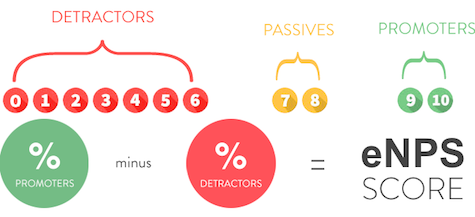Employee Net Promoter Score (eNPS) is a valuable metric that allows organizations to gauge the loyalty and satisfaction levels of their employees. It is derived from the customer loyalty metric, Net Promoter Score (NPS), and is a highly effective tool for measuring and improving employee engagement.
Defining Employee Net Promoter Score (eNPS)
eNPS is a measurement system that assesses how likely employees are to recommend their organization as a place to work. It is based on a simple question: “On a scale of 0 to 10, how likely are you to recommend our company as a place to work?” Employees are categorized into three groups based on their responses:
- Promoters (score 9-10): These employees are highly satisfied and loyal. They actively promote the company as a great place to work.
- Passives (score 7-8): These employees are generally satisfied but not as enthusiastic as promoters. They are less likely to actively promote the company.
- Detractors (score 0-6): These employees are dissatisfied and may actively discourage others from working at the company.
The eNPS is then calculated as the difference between the percentage of promoters and the percentage of detractors.
eNPS = % Promoters – % Detractors
The Origin of eNPS
The concept of eNPS was first introduced by Fred Reichheld in 2003 as a way to measure and monitor employee loyalty. It borrows from the NPS framework used to measure customer loyalty and has proven to be a valuable tool in understanding employee satisfaction and engagement levels.
Reichheld, a renowned business strategist and author, recognized the need for a simple yet effective method to gauge employee loyalty. He believed that by measuring the likelihood of employees recommending their organization as a place to work, companies could gain valuable insights into their workforce’s satisfaction and engagement levels.
Reichheld’s groundbreaking concept was met with enthusiasm and quickly gained traction in the business world. Organizations saw the potential of eNPS as a powerful metric to evaluate their employee experience and make informed decisions to improve it.
Key Components of eNPS
In addition to the net score, eNPS takes into account the open-ended feedback provided by employees. These comments offer valuable insights into the reasons behind the given scores. This allows organizations to identify specific areas for improvement and take appropriate action.
The open-ended feedback is a crucial aspect of eNPS as it provides qualitative data that complements the quantitative net score. It allows organizations to understand the underlying factors influencing employee loyalty and satisfaction. By analyzing the feedback, companies can uncover patterns, trends, and recurring themes that can guide their efforts in creating a positive work environment.
Furthermore, the open-ended feedback encourages employees to express their thoughts and concerns openly, fostering a culture of transparency and trust. This can lead to increased employee engagement and a stronger sense of belonging within the organization.
Organizations that effectively leverage the open-ended feedback from eNPS surveys can gain a competitive advantage by addressing specific issues and implementing targeted improvements. By listening to their employees and taking action based on their feedback, companies can create a workplace that attracts and retains top talent.
The Importance of eNPS in Business
eNPS, or Employee Net Promoter Score, plays a crucial role in driving employee engagement and ultimately impacts an organization’s overall performance. By measuring and improving employee satisfaction levels, eNPS serves as a powerful tool for organizations to enhance their workforce and achieve success.
Role of eNPS in Employee Engagement
Engaged employees are the backbone of any successful organization. They are more likely to be invested in their work, perform better, and stay longer with the company. With eNPS, organizations can gain valuable insights into employee satisfaction levels and identify areas where improvements can be made.
By regularly measuring eNPS, organizations can assess the overall sentiment of their workforce. This allows them to address any concerns or issues that may be affecting employee engagement. By actively listening to their employees and taking action based on the feedback received, organizations can create a positive work environment that fosters engagement and productivity.
Furthermore, eNPS provides a platform for employees to voice their opinions and concerns anonymously. This anonymity encourages honest feedback, enabling organizations to understand the true sentiments of their workforce. By addressing these concerns, organizations can build trust and improve employee satisfaction, leading to higher engagement levels.
eNPS and Organizational Performance
Organizations with higher eNPS typically have a more motivated and productive workforce. Engaged employees are more likely to go the extra mile, resulting in increased customer satisfaction, improved quality of work, and enhanced overall performance.
When employees are engaged and satisfied, they are more likely to deliver exceptional customer service. They understand the importance of their role in the organization’s success and are motivated to provide the best possible experience to customers. This, in turn, leads to higher customer satisfaction levels, increased customer loyalty, and ultimately, business growth.
In addition to customer satisfaction, eNPS also impacts the quality of work produced by employees. Engaged employees are more likely to take pride in their work, pay attention to detail, and strive for excellence. This results in higher-quality products or services, which can give organizations a competitive edge in the market. Highly engaged and satisfied employees results in more loyal customers as shown in the promoter flywheel.
Gallup’s State of the American Workplace, reports that companies in the top quartile of employee engagement have 10% higher customer ratings indicating a connection between employee engagement and customers.
Moreover, organizations with high eNPS tend to have lower employee turnover rates. Engaged employees are more likely to stay with the company for the long term, reducing recruitment and training costs. This stability within the workforce allows organizations to build a strong and cohesive team, leading to improved collaboration and efficiency.
How to Calculate eNPS
Calculating eNPS is a straightforward process that involves gathering employee feedback and interpreting the results:
Employee Net Promoter Score (eNPS) is a metric used by organizations to measure employee loyalty and engagement. It is derived from the Net Promoter Score (NPS) concept, which is commonly used to measure customer loyalty. By applying the same principles to employees, organizations can gain valuable insights into their workforce’s satisfaction and likelihood to recommend the company as a great place to work.
Gathering Employee Feedback
Organizations can obtain employee feedback through surveys or dedicated employee communication platforms like HubEngage. These platforms provide a convenient and efficient way to gather feedback from employees, allowing organizations to gain a comprehensive understanding of their workforce’s sentiments.
Surveys can be designed to cover various aspects of the employee experience, such as job satisfaction, work-life balance, career development opportunities, and company culture. By asking targeted questions, organizations can identify areas of strength and areas that need improvement.
Anonymous surveys are particularly effective in encouraging honest responses. When employees feel that their feedback is anonymous, they are more likely to express their opinions and concerns openly, providing organizations with valuable insights into the factors that impact their engagement and loyalty.
Interpreting the eNPS Results
Once the survey data is collected, organizations can calculate the eNPS by subtracting the percentage of detractors from the percentage of promoters. Promoters are employees who respond with a score of 9 or 10 when asked how likely they are to recommend the company as a great place to work. Detractors, on the other hand, are employees who respond with a score of 0 to 6.
The resulting eNPS score ranges from -100 to +100. Higher scores indicate a more positive eNPS, reflecting a higher level of employee loyalty and engagement. A positive eNPS suggests that employees are more likely to recommend the company to others, which can have a positive impact on recruitment efforts and overall company reputation.
It is important to note that eNPS is just one metric in a comprehensive employee feedback strategy. Organizations should also consider other factors, such as qualitative feedback and specific action plans to address areas of improvement identified through the eNPS survey.
By regularly measuring and analyzing the eNPS, organizations can track changes in employee sentiment over time and take proactive steps to improve employee engagement and satisfaction. This can lead to higher productivity, lower turnover rates, and a more positive work environment.
Implementing eNPS in Your Organization
Introducing eNPS into your organization requires careful planning and execution. Follow these steps to successfully implement eNPS:
Steps to Introduce eNPS
1. Gain leadership buy-in: Obtaining support from senior management is crucial for the successful implementation of eNPS. Highlight the potential benefits and explain how eNPS aligns with the organization’s goals.
Implementing eNPS in your organization can be a transformative process. By gaining leadership buy-in, you ensure that the initiative receives the necessary resources and attention. Senior management support is essential for creating a culture of feedback and continuous improvement. It demonstrates to employees that their opinions matter and that the organization is committed to their satisfaction and engagement.
2. Set clear objectives: Define the purpose of the eNPS initiative and outline what you hope to achieve. This clarity will guide the entire process and help measure its effectiveness.
Setting clear objectives is crucial for any successful initiative. When implementing eNPS, it is important to define what you aim to accomplish. Whether it’s improving employee satisfaction, identifying areas for growth, or enhancing overall organizational performance, having well-defined objectives will ensure that the eNPS survey aligns with your organization’s strategic goals.
3. Choose the right survey tool: Selecting an employee communication platform like HubEngage ensures a user-friendly and efficient experience for both employees and administrators.
Choosing the right survey tool is essential for a smooth and effective eNPS implementation. Platforms like HubEngage provide user-friendly interfaces that make it easy for employees to participate in the survey. These tools also offer robust analytics and reporting features, allowing administrators to gather and analyze data effectively. By selecting the right survey tool, you can streamline the entire eNPS process and maximize its impact.
4. Communicate the purpose and process: Clearly communicate the intention behind the eNPS survey to employees. Address any concerns or questions they may have and emphasize the importance of their honest feedback.
Effective communication is key when implementing eNPS. It is essential to clearly communicate the purpose and process of the survey to employees. By doing so, you create transparency and build trust, encouraging employees to provide honest feedback. Addressing any concerns or questions they may have will further enhance their willingness to participate and contribute meaningfully to the eNPS initiative.
5. Analyze and act on the results: Once the eNPS scores are obtained, analyze the data and identify areas for improvement. Develop action plans and communicate the steps being taken to address any pain points.
Obtaining eNPS scores is just the beginning. To drive positive change, it is crucial to analyze the data collected and identify areas for improvement. By conducting a thorough analysis, you can gain valuable insights into employee sentiment and identify specific pain points within the organization. Based on these findings, develop action plans and communicate the steps being taken to address the identified areas for improvement. This proactive approach demonstrates to employees that their feedback is valued and that their concerns are being addressed.
Overcoming Potential Challenges
Implementing eNPS may encounter some challenges, such as low response rates or resistance to change. To overcome these challenges, it’s essential to:
- Assure employees that their feedback matters and will be taken seriously.
- Highlight the benefits of eNPS and how it will drive positive change within the organization.
- Continuously communicate the progress made based on the eNPS feedback.
Low response rates and resistance to change are common challenges when implementing eNPS. To address these challenges, it is crucial to assure employees that their feedback matters and will be taken seriously. Emphasize the benefits of eNPS, such as its ability to drive positive change and enhance employee satisfaction. By continuously communicating the progress made based on the eNPS feedback, you can keep employees engaged and motivated to participate in future surveys.
Optimizing eNPS for Better Results
Implementing eNPS is a significant step towards improving employee engagement, but it doesn’t stop there. To truly maximize the benefits of eNPS, it is important to continuously optimize the process. By fine-tuning and refining your approach, you can enhance the accuracy of your results and drive meaningful change within your organization.
Here are some strategies to consider when it comes to improving eNPS:
Regularly Review and Update eNPS Survey Questions
One key strategy is to regularly review and update the eNPS survey questions. Employee sentiment can evolve over time, so it’s important to ensure that your survey questions accurately capture their current thoughts and feelings. By staying up-to-date with the latest trends and concerns, you can gather more insightful data and address emerging issues more effectively.
Consider conducting focus groups or seeking feedback from employees to gain a deeper understanding of their needs and concerns. This qualitative data can help you refine your survey questions and make them more relevant and impactful.
Measuring the Impact of eNPS Improvements
Improving eNPS is not just about making changes; it’s also about measuring the impact of those changes. Automated recurring surveys, such as those available through platforms like HubEngage, can be incredibly valuable in this regard.
These platforms allow organizations to monitor changes in eNPS over time, providing valuable insights into the effectiveness of specific initiatives. By conducting regular surveys, you can track the impact of your efforts to improve employee satisfaction and engagement. This data can help you identify which strategies are working and which ones may need further refinement.
In addition to measuring the overall eNPS score, it’s important to analyze the individual components that contribute to it. By examining the drivers behind the score, you can gain a deeper understanding of what factors are influencing employee engagement and satisfaction. This knowledge can guide your future initiatives and help you prioritize areas for improvement.
Furthermore, it’s crucial to communicate the results of your eNPS surveys to employees. Sharing the data and insights gained from the surveys demonstrates transparency and shows that their feedback is valued. This can foster a sense of trust and encourage employees to continue providing honest and constructive feedback.
The Future of eNPS
The employee feedback landscape is continually evolving, and eNPS is expected to evolve along with it. Here are a couple of future trends to consider:
Trends in Employee Feedback
Organizations are increasingly leveraging technology to gather real-time employee feedback. Traditional annual or bi-annual surveys are being replaced by continuous feedback systems that provide immediate insights and allow for quicker intervention.
Innovations in eNPS Tools and Techniques
As technology advances, eNPS tools and techniques are becoming more refined. Automated survey platforms like HubEngage are incorporating advanced analytics and predictive capabilities to provide organizations with deeper insights and proactive solutions to improve engagement and drive positive change.
In conclusion, eNPS is a powerful metric that organizations can use to measure employee loyalty, satisfaction, and engagement. By implementing eNPS and utilizing employee communication and survey platforms like HubEngage, organizations can better understand their employees’ needs and take concrete steps to improve their experience at work. Regular automated recurring surveys can monitor employee NPS and provide valuable insights to drive continuous improvement. Embracing eNPS and utilizing technology to optimize its use will undoubtedly contribute to a thriving and engaged workforce.
See how HubEngage’s survey platform provides a comprehensive set of employee survey tools to measure and track eNPS.















